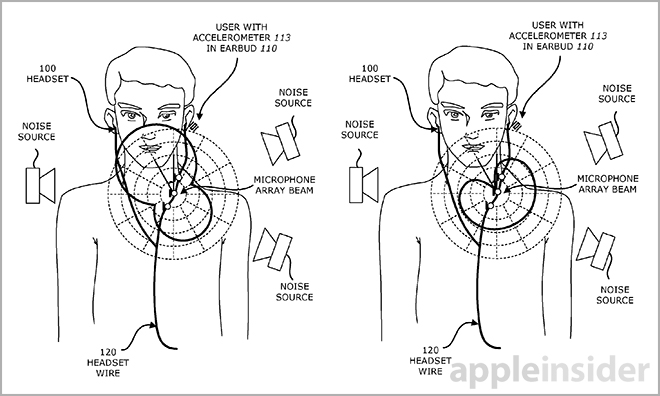Apple is looking to advance the design of its bundled iPhone EarPods by potentially implanting an accelerometer into the earbud portion that could recognize voice activity, which in turn would activate and tune beamforming microphone arrays.
According to a patent application published by the U.S. Patent and Trademark Office on Thursday, Apple is investigating an enhanced headphone device that can recognize a user's voice, activates multiple on-board microphones, turns on a noise suppression system and directs beamforming mics toward a user's head.
According to Apple's "System and method of detecting a user's voice activity using an accelerometer" the enhanced earbuds are loaded with on-board sensors, including an accelerometer and two microphones. These sensors, in tandem with a microphone array located along the headphone wire, form a noise-suppressing system much more advanced than the company's EarPods product.
The method begins with the accelerometer. In some embodiments, the sensor is used as a voice activity detector (VAD) that detects vibrations generated by a user. Both voiced speech (generated by a user's vocal chords) and unvoiced speech (generated without use of vocal chords) can be detected by the accelerometer via vibrations propagating through tissue and bone.
Detected accelerometer vibration data from is joined by signals from front- and rear-facing microphones embedded in one or both earbuds. In some embodiments, the accelerometer is tuned to detect lower frequency vibrations in what is called a VADa system. Alternatively, signals output from the two microphones can be used to determine voiced speech, or a VADm arrangement.
The VAD system scans for both voiced (VADv) and unvoiced (VADu) signals, which are combined with other signal data to inform a noise suppression circuit. Based on the information, noise from the area surrounding a user can be estimated and an effective beamforming algorithm can be applied to the system's various mic arrays.
In some embodiments, mics located in the heaphones and along the unit's wire are set to a general beamform directed at the user's face. Alternatively, a more active beamformer is described that can be adaptively steered depending on VAD output. For example, the accelerometer-based VAD can be used to steer the beamformer toward a user's mouth.
Alternatively, a noise suppression system can be made more effective by steering microphones in the direction of ambient noise not associated with voiced or unvoiced speech, which is then removed from the signal.
It is unknown whether Apple will implement the invention in a future earphone, though the EarPods would certainly benefit from noise-canceling tech. Hardware already exists to build such a system, as seen in the MacBook lineup's beamforming mics.
Apple's VAD-equipped headphone patent application was first filed for in March 2013 and credits Sorin V. Dusan, Esge B. Andersen, Aram Lindahl and Andrew P. Bright as its inventors.
 Mikey Campbell
Mikey Campbell







-xl-m.jpg)


-m.jpg)






 Chip Loder
Chip Loder
 Thomas Sibilly
Thomas Sibilly
 Wesley Hilliard
Wesley Hilliard
 Christine McKee
Christine McKee
 Amber Neely
Amber Neely
 William Gallagher
William Gallagher
 Malcolm Owen
Malcolm Owen









13 Comments
How about reducing sound leakage first?
How about getting rid of the wires? In this age of wireless, I'm surprised Apple isn't working on a new bt headset. It's a market that has seen little innovation in my opinion, and one that could use Apple's prowess at battery management and aesthetic design.
How about getting rid of the wires? In this age of wireless, I'm surprised Apple isn't working on a new bt headset. It's a market that has seen little innovation in my opinion, and one that could use Apple's prowess at battery management and aesthetic design.
power and sound quality. Let battery progress and kinetic charging evolve.
I see this (if it ever happens) as more tightly tying the 'ecosystem' together. This is the correct order... improve sound capture, personalize and learn the 'owner', start 'recognizing' head gestures.
How about reducing sound leakage first?
leakage in? mic's on the earphone's work for sound cancellation. if you 'feel' a wave, that doesn't align with 'voice' of your owner, you can create an out of phase wave to cancel it out.
leakage out (my son's buds playing 311 at '11')... that's a different problem;-)
power and sound quality. Let battery progress and kinetic charging evolve.
I see this (if it ever happens) as more tightly tying the 'ecosystem' together. This is the correct order... improve sound capture, personalize and learn the 'owner', start 'recognizing' head gestures.
He might mean... the sound comes out loud from earphones while you are listening to music.
Id really like to see BlueTooth EarPods. The same but no stem. The only thing is the control.